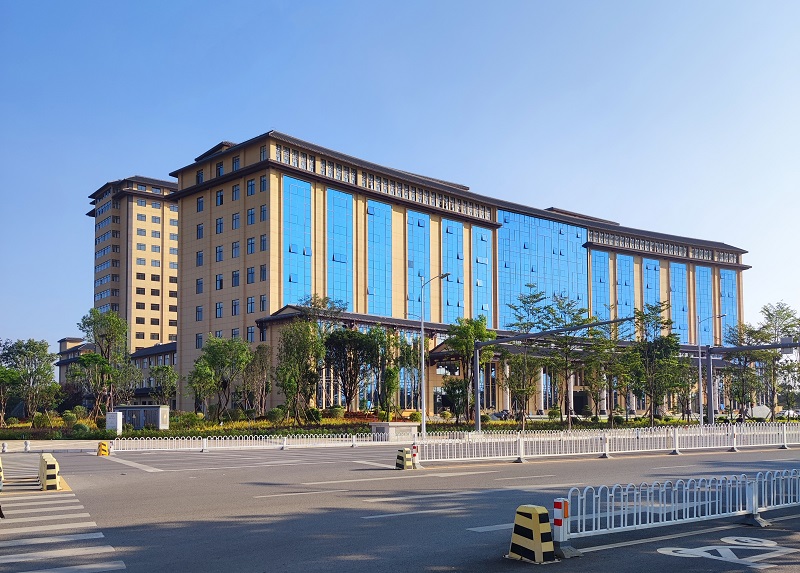Formaldehyde pollution, is since ancient times, or the product of modern industry?
The ancient architecture is magnificent and resplendent, with a distinctive style. Why have never heard of the ancient formaldehyde poisoning, but now the new house often appear formaldehyde exceeds the standard, decorate the new house after half a year to move in?
With the progress of The Times, people gradually have requirements for indoor air quality, I believe that many of us have heard similar words, why the rapid spread of knowledge of formaldehyde harm in recent years, formaldehyde poisoning cases are frequently mentioned, is the capital to create panic, or indeed this matter?
We extend our perspective to ancient architectural complexes to see how ancient houses were built...

Although there is no modern scientific and technological products in ancient China, the exquisite attention to details is not as good as today‘s handicraft. Although the decoration is multifarious, but that can be pure natural pollution-free.
The main building materials of ancient houses are: glazed tiles, wood, face tiles, green bricks, ancient building green tiles and so on
Glass tile
Glass tile is made of ore as raw material, through high temperature. It has very strong water resistance.
wood
The lumber commonly used in ancient building, it is log and saw commonly the board square timber that becomes a piece, in big wood most commonly used is fir, also useful at the same time pine, mollusk, ju, cypress, nan
Ancient building tiles, green tiles are mainly made of natural clay, forged from. It is generally used in the construction of houses.

The wood used is not now widely spread on the market of wood-based panels, but solid solid wood. In order to prevent insects and corrosion, the wood used in the construction is dried for several years, and then made into clinker, the quality is guaranteed.
By using mortise and tenon joints, an elastic frame can withstand large loads, which is strong and safe.

But for modern assembly line production, it is almost difficult to do, are a large number of artificial boards soaked in formaldehyde solution, to achieve the purpose of insect prevention and corrosion. The use of formaldehyde rich glue, will be a variety of plate bonding, which can not be underestimated formaldehyde content.
If it is only the rich who can afford to build such houses, what do the poor live in? Generally, it is made up of dirt, and then almost is thatched hut, natural cave dwelling, etc., although simple, formaldehyde is really not much.
We are now the main ingredient of indoor pollution, is a large number of adhesive used in decoration, as the saying goes, "no aldehyde glue, no benzene paint", in fact, a large part of indoor formaldehyde comes from all kinds of formaldehyde glue!
However, in ancient buildings, some places also need to use glue. How did the ancients choose something that can replace formaldehyde glue with their wisdom? One historian has answered the question:
No formaldehyde glue, no trouble bonding
Ancient architecture: the use of natural glutinous rice as the main material, made into formaldehyde-free adhesive glutinous rice pulp.
Glutinous rice is the grain of glutinous rice, as early as the pre-Qin period has been an important food in southern China, the north known as "jiangmi". Unlike ordinary rice, glutinous rice turns into a particularly sticky mess when cooked, then becomes hard again after dehydration and drying. Perhaps someone got the idea to introduce glutinous rice into the construction industry.
Sticky rice, transformed into organic building materials, acts as the "glue of adhesives". After the glutinous rice is boiled, craftsmen pour the slurry into sanhe soil to make mortar. When it is dried, it is stronger and more ductile than soil mortar, and has excellent waterproof performance.
After song and Yuan dynasties, the use of glutinous rice mortar became more mature. The famous Works of the Ming and Qing Dynasties, such as the Forbidden City in Beijing, the Great Wall of the Ming Dynasty, the Chengde Summer Resort, the Eastern and Western Tombs of the Qing Dynasty, and the Qiantang River Seatang, were all built with mortar made of glutinous rice juice and clay to bond bricks and stones, which have remained largely intact for hundreds of years.
Not only that, the use of glutinous rice mortar construction, owners should be limited to this kind of large projects at any cost, ordinary civilian housing in addition to fujian tulou such alternative, rarely can use this strong material. Even the wall of Beijing, built after the relocation of the capital in the Ming Dynasty, was not made of glutinous rice mortar.
The production of glutinous rice mortar is complicated and slow, and the use of workers requires high skills. Compared with the current chemical glue, the cost is high and the process is tedious. However, in order to pursue efficiency, the handicraft of sticky rice mortar cannot be satisfied. Therefore, it is not difficult to understand why the construction process no longer uses sticky rice mortar.

Paint is high in formaldehyde, which is not used in ancient times
Contemporary decorate, besides glue kind broad demand, paint also became indispensable one part.
In order to ensure its film forming efficiency, improve protection, decoration and weather resistance, will add a variety of fillers, additives, etc., seriously affect indoor safety and health.
And in ancient times, furniture adornment never uses paint, what use is a kind boil by a few kinds or 10 kinds of plants make, take out pure, a kind of oil that merges and forms similar paint, absolutely natural environmental protection.
Nowadays, due to the market demand, we pay much attention to the time and efficiency of everything. It is difficult for us to do everything as "elaborate" as the ancients. All are mass produced by factories, and all additives are added directly to achieve any effect, without considering whether such substances are harmful to our human body.
Therefore, we can see the cases of carcinogenic death due to formaldehyde poisoning, frequently reported.

We can‘t go back to the past, can‘t easily appeal to return to nature, there is no way to avoid indoor pollution after decoration, we can do is to cause pollution on the road, try our best to slow down a little, or a little less, for the whole environment is so.
Therefore, we have been calling for the protection of natural environment and the importance of indoor air environment. Give people the protection to stay indoors for the longest time.
Although, even if we can do light decoration, we can not completely avoid the harm of indoor pollution. After all, after the accumulation of all indoor furniture and items, the formaldehyde overstandard rate is very high, and the release period of formaldehyde is as long as 3 to 15 years, which is not so easy to solve. So what do we do?
In fact, many consumers emphasize indoor air purification, has not been limited to the addition of formaldehyde, especially after the epidemic, sterilization of viruses and PM2.5 has become another focus of governance. Shanghai jiaotong University professor, guangdong province indoor environment health industry association air purifies product chief researcher Wu Jixiang thinks, at present indoor air is polluted purify, include purify formaldehyde, eliminate the new technology such as kill bacteria to be reflected centrally on new-style air purify lamp.

Shenzhen lighting and display industry association, vice President of engineering, guangdong should light technology chairman xiao yue ping thinks, at present all sorts of lamps and lanterns of health product innovation and upgrading, add kill germs, module and purification function, through the principle of adsorption, catalysis and biology enzyme purification, on indoor particulate and gaseous pollutants, have the effect of the removal.

It has the air purification lamp which can kill coronavirus, formaldehyde and virus
For this, conditional consumer can be equipped air purification equipment when decorating, be like air purifier of lamp of air purification, disinfection, air, new fan and healthy air conditioning.
"Whether it‘s aldehyde removal products or air cleaning equipment, as long as the indoor air quality is up to standard, it‘s good." Consumer Wang said. A lot of consumer is polluted to manage indoor air effectively quickly, can look for orgnaization of a few air to come to serve, perhaps assemble the lamps and lanterns that a few have air purify.

It is reported that the "civil building engineering indoor environmental pollution control standard" (GB50325-2020) stipulates that the formaldehyde concentration limit standard in indoor air is 0.07mg/m3, and the more stringent international standard is 0.03mg/m3. Stricter standards should be met for children, the elderly, pregnant women and the sick. Consumer is choosing indoor environment purify product, because should have the detection report that issue SGS (internationally recognized sterilization report) or wide microbe sterilization report.
Xiao should be said, when consumers choose air purification lamps and lanterns to see whether the regular sterilization report, as well as the important air purification test report, and most important, is whether the product can do human coexistence, such ability in under the premise of guarantee personnel‘s health and safety, to kill germs, in addition to aldehydes pollen effect, such as giving consumers the greatest protection.







